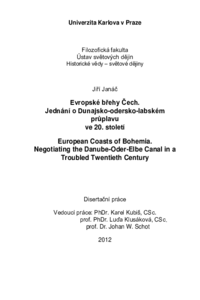European Coasts of Bohemia. Negotiating the Danube-Oder-Elbe Canal in a Troubled Twentieth Century
Evropské břehy Čech.Jednání o Dunajsko-odersko-labském průplavu ve 20. století
dizertační práce (OBHÁJENO)

Zobrazit/
Trvalý odkaz
http://hdl.handle.net/20.500.11956/59345Identifikátory
SIS: 101601
Kolekce
- Kvalifikační práce [22841]
Autor
Vedoucí práce
Oponent práce
Homburg, Ernst
Kaijser, Arne
Fakulta / součást
Filozofická fakulta
Obor
Historie/obecné dějiny
Katedra / ústav / klinika
Ústav světových dějin
Datum obhajoby
10. 12. 2012
Nakladatel
Univerzita Karlova, Filozofická fakultaJazyk
Angličtina
Známka
Prospěl/a
Evropské břehy Čech. Jednání o Dunajsko-odersko-labském průplavu ve 20. století Abstrakt Tato práce analyzuje integrační procesy v Evropě z perspektivy projektu průplavu Dunaj-Odra-Labe (DOL). Pod pojmem integrace jsou zde míněny především aktivity směřující k vytváření ucelených infrastrukturních systémů. Práce vychází z konceptu "skryté integrace," který se opírá o dva základní předpoklady: 1) počátky integrace (a fragmentace) kontinentálních infrastrukturních sítí předcházely pokusům o politickou integraci a lze je datovat do 19. století; 2) integrační procesy na poli infrastruktur byly spíše dílem transnacionálních expertních organizací než diplomatů reprezentujících zájmy národních států. Skutečnost, že průplav DOL nebyl nikdy realizován, umožňuje jeho prostřednictvím studovat vývoj snah o vytvoření jednotné plavební sítě na kontinentě. Takové iniciativy ovšem často vycházely ze vzájemně nekompatibilních až protichůdných představ budoucího uspořádání Evropy. Na základě studia příprav projektu průplavu DOL lze identifikovat čtyři hlavní integrační rámce, které expertní organizace využívali k legitimaci svých integračních projektů: mittel-evropeizaci, nacifikaci, sovětizaci a evropeizaci. Tyto integrační rámce představují nejen specifické vize prostorového uspořádání vodocestné sítě na kontinentu, ale...
European Coasts of Bohemia. Negotiating the Danube-Oder-Elbe Canal in a Troubled Twentieth Century Abstract This thesis looks at the integration processes in Europe from the perspective of a single waterway project, the Danube-Oder-Elbe Canal (DOE). In doing so, it draws on the recent strand of scholarly literature considering the process of European integration as an outcome of transnational networking, system building and infrastructure development. Two core assumptions of such an approach, labeled "hidden integration" claim: (1) that the process of integration (and frag- mentation) of infrastructures on the continent began back in the nineteenth century, and (2) the integration processes were driven by transnational expert organizations rather than diplomats representing nations states and their interests. The DOE Canal project, though never completed, traces the history of ef- forts aimed at establishing an integrated inland navigation network in Europe. These proposals were promoted and performed with very different and often conflicting visions of Europe. The thesis identifies a set of four different integration frameworks used by transnational system builders to justify the need for integration: Mittel-Europeanization (Central Europeanization), Nazification, Sovietization and Europeanization. These...
